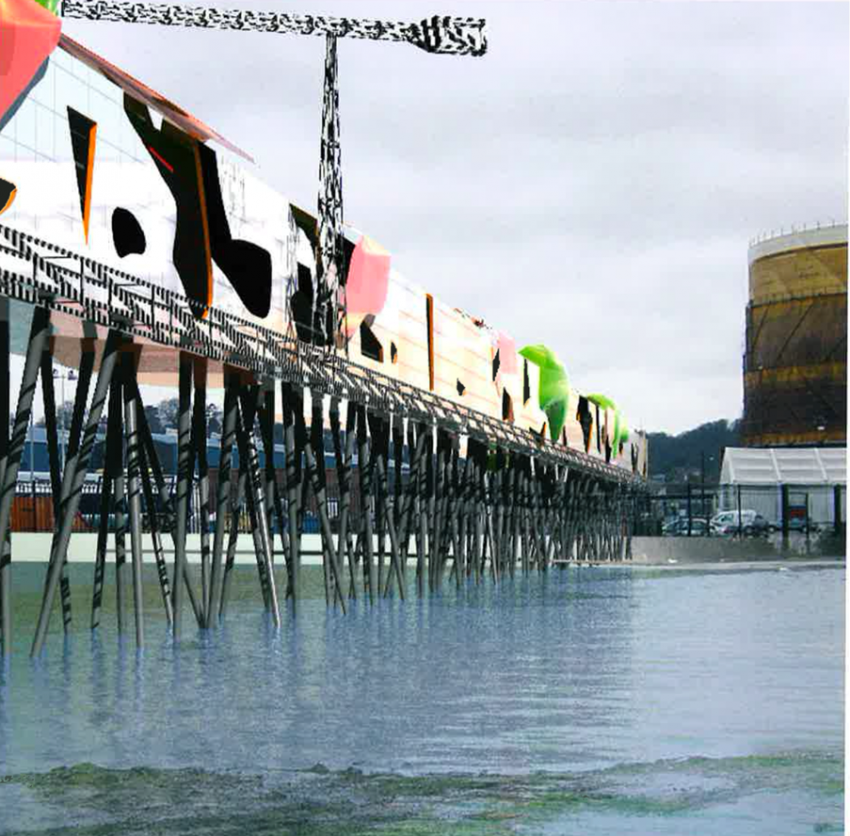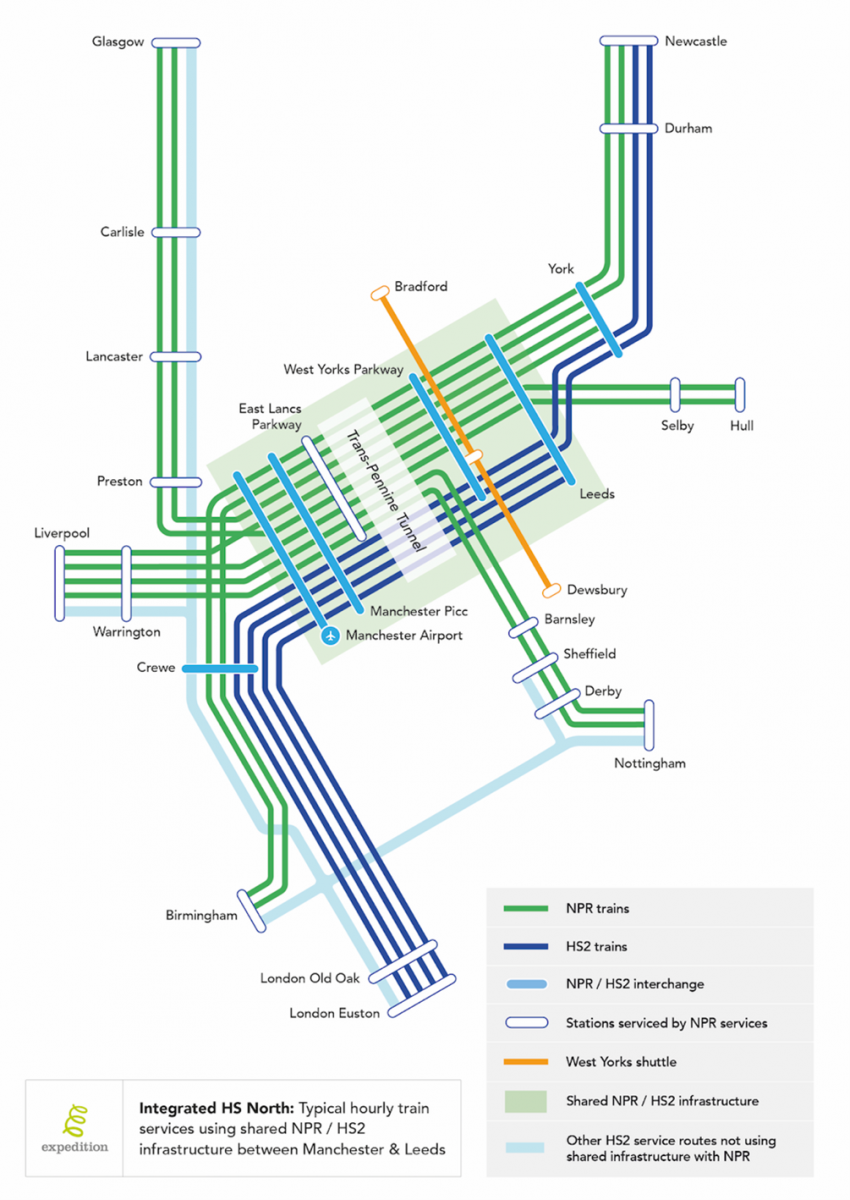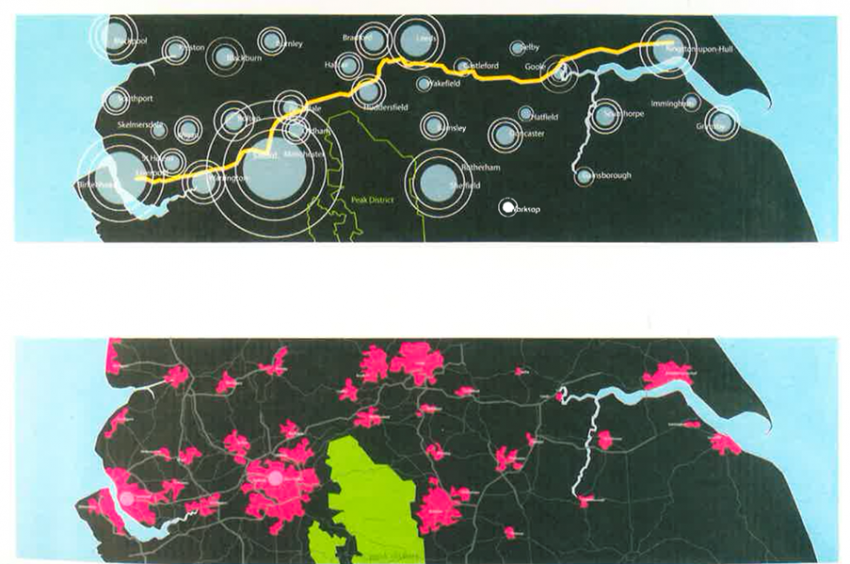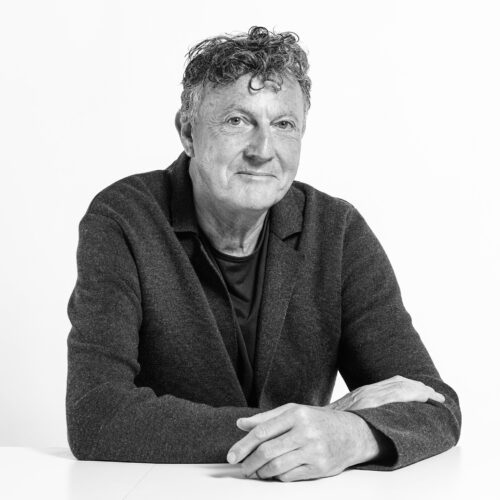In 2005 I went to see the exhibition “SuperCity” in Manchester at Urbis, the museum of urban life, a great venue sadly long since closed. SuperCity was the brainchild of the late Will Alsop, very much in the tradition of Archigram and Will’s former mentor Cedric Price. It was “a visionary daring prophesy for the North of England – a future where the vast M62 corridor is a singular entity, a huge coast to coast ‘SuperCity’, 80 miles long and 15 miles wide.”

The exhibition explored Alsop's radical vision in the light of the then Deputy Prime Minister John Prescott's plan to regenerate northern England, the “Northern Way Strategy”. The previous year Manchester based engineer Martin Stockley proposed a Liverpool-Manchester-Leeds- Hull corridor, continuing to Europe. This was a huge missed opportunity, if some of the ideas in these proposals had been enacted the outcome of the 2016 Brexit referendum might have been very different. The 2008 Global Financial Crisis was a major disrupter, contributing to little happening in the North, London continued to thrive whereas Northern opportunities were not explored.

Historic regional divisions
This is a historic problem in the UK. Other countries have more equality in the distribution of opportunities between their cities. Germany has Munich, Berlin, Frankfurt, Hamburg, Cologne, Stuttgart. Nowhere in France, Italy or Spain has the dominance on their country’s economies that London has. The concept of rebalancing the UK GDP has been around even longer than the SuperCity. Many politicians have put forward similar proposals, Benn, Heseltine, Major, Blair, Brown all tried, and had limited success. But to achieve lasting change not fleeting notoriety (remember Nigel Coates’s drum shaped National Centre for Popular Music in Sheffield?) we need a clear vision.
Creating individual identities
Will Alsop’s approach is still relevant to us today. Each individual town or city needs to build on their own identity and strengths. As Bridget Sawyers wrote in her 2005 appraisal of the Northern Way “It is acknowledged that the money from isolated retail schemes and grand cultural projects is failing to reach deprived city areas. These are not attractors to the ‘new creative class’ that commentators say are key to urban renaissance.”
Sawyers stressed the individual strengths of the towns and the necessity to be distinctive. “Academic and government policy research has confirmed that a key factor in the economies of successful regions is the presence of thriving clusters of businesses with networks to support them.” She identified five clusters in the Yorkshire region “advanced engineering and metals; bioscience; chemicals; digital industries, and food and drink” While the North West Development Agency’s clusters were identified as “aerospace, automotive, aviation, biotechnology, chemicals, creative industries, construction, digital industries, energy, environmental technology, financial and professional services, food and drink, maritime, sport, textiles and tourism”.
Sawyers points out local and regional successes in the region: “In Leeds around a third of the city’s £9billion GDP is generated by the financial and business services sectors. In Sheffield a booming sector is digital and creative industries with companies in film-making, music production, publishing, new media, craft and the arts.”
In Manchester, the inspirational Councillor Richard Leese was instrumental in attracting the Commonwealth Games to the City, Sawyers quoted him as saying “Manchester has all the pieces in place to develop a true Knowledge Capital. This vision is bold. … It will provide the perfect focus for the incubation of high technology businesses while embracing creative industries and the service sector. Manchester Knowledge Capital will deliver social benefits too, leading to a better quality of life for all.” This has come to fruition in recent years with The University of Manchester leading two of the largest robotics projects ever funded in the UK. The University is currently the central point for a wealth of research on robotics and AI. These projects not only gather the talent within the University of Manchester but bring together the best robotics researchers from across the UK. James Baker, CEO of Graphene@Manchester is shaping and building a skilled workforce, a key part of re-establishing a Britain fit for the future with a relevant Industrial Strategy.
What is the Northern Powerhouse?
It is clear then that there was, and still is great ambition, real talent, energy and enthusiasm in our Northern towns. The idea of a 'Northern Powerhouse' is not new, it was first introduced in June 2014 by George Osborne, then the Chancellor of the Exchequer, but the people in the Northern towns, and elsewhere were, and still are, tired of empty promises and no action.
What we need is greater clarity on what the Northern Powerhouse is. Where and for what businesses should Enterprise Zones be established? What should be made and where? How do we attract the brightest and best from all over the world, and retain the intelligence and talent in the regions? How do we ensure that Northern towns and regions are co-operating, not competing for the same pots of money?

It’s time to revisit the ideas in the SuperCity exhibition to see if they are relevant to our current Northern Powerhouse and how they can be incorporated. Some progress has been made since 2014: new mayors have been appointed, new bodies such as Transport for Greater Manchester and Transport for the North formed. But studying the Northern Powerhouse website there appears to be little, as yet joined up thinking.
The main focus of the Northern Powerhouse is a list of projects including the following:
- The £380 million upgrade of the A1(M) London to Newcastle aimed at reducing journey times by 20%. But there is no detail of how it will help forge the Northern Powerhouse.
- The £16 million development of the Halton Curve allowing direct trains between north Wales and Liverpool for the first time in decades. Again no detail on the impact to the Northern Powerhouse.
- The first Sunderland bridge over the River Wear for 40 years, linking Castletown with Pallion. This has opened up the long-neglected south bank of the river for regeneration and development but what is its wider impact?
- A rapid bus transport scheme developed to improve public transport between Accrington, Blackburn and Darwen linking in with rail lines.
- A £16 million Government investment in new and improved cycling lanes is helping to cut journey times in Newcastle.
These are laudable and important projects but they all have the hallmarks of an episode of “Yes Minister” compiling a list of random unconnected projects to demonstrate that something is happening. They are unlikely to have the manufacturing centres of Germany or the innovation centres of American and Asia quaking in their boots. In the meantime China is forging ahead and Saudi Arabia has launched its own ambitious NEOM project.
Similarly greater clarity is needed establishing centres of excellence. The Northern Powerhouse website has great ambitions stating “our vision is to provide world-class education, training and care for everyone, whatever their background. It will make sure that everyone has the chance to reach their potential, and live a more fulfilled life. It will also create a more productive economy, so that our country is fit for the future.” Yet it is less convincing on the detail of how to achieve this.
The region is currently making progress with several initiatives including National Colleges such as the National College for Nuclear (Cumbria) and the National College for High Speed Rail (Doncaster), as well as a Northern Sponsor Fund to help establish multi-academy trusts and twenty T Level providers in this region. An analysis of the region’s academic specialisms and a coherent policy of attracting the world’s best in a coordinated strategy alongside industry is surely the way forward. We need to agree where the centres of excellence are so that the regions are not competing. Is Manchester leading materials technology? Sunderland electric cars? Hull solar and wind power? Leeds perhaps Fintech and financial innovation?
And where is battery technology, pharmaceuticals, Life Sciences, Artificial Intelligence, Robotics and Biotech?
Looking back on Alsop’s ideas (it would be incorrect to call them proposals) they are varied and extensive, typically Architectural, they contained beautiful drawings and models, full of evocative imagery. It is often beholden on Architects to stretch the imagination and to lead opinion, and Alsop’s ideas certainly achieved this. He’s was a radical vision. He railed against grafting new homes on to existing settlements. “Using existing transport links- the motorway, and where possible, high speed rail- I propose a series of brand-new settlements as centres of high energy. These should be designed in their totality by leading architects to ensure that all are different. …. These new cities, linear and polycentric, will take pressure off our traditional centres and be in themselves dynamic and culturally diverse settlements.”
Martin Stockley worked closely with Alsop. Martin told me that Will never made proposals, he made propositions - what if, how about if etc? “If we draw an Italian hill town how might it make us think about Barnsley? I can’t speak for him but I always thought that painting was to him a proposition. Make this mark on a wall and what does it say to me about this project? Ideas are nothing until expressed and painting and drawing when done in a divergent non-solution oriented way shift you to approach things more developmentally. A lot of our urban design and masterplanning is painting by numbers and soulless. You have to have a broad proposition then develop parts and see what happens.”
SuperCity has its origins in Superstudio’s 1969 “Continuous Monument” which wasn’t in fact an urban design proposal but a visual critique of urbanisation. Adolfo Matalini of Superstudio described it as a possible outcome of the horrors architecture had in store, with bits scientific methods for perpetuating models worldwide.

One of Alsop’s ideas was for a 5,000 people dwelling. He even wrote an account from the pen of a fictitious resident from the 23rd floor of Village Coastal, Pink Rose city: “I live in a beautiful URBAN SPRAWL, in a dissected city with no streets, avenues, boulevards, closes, loakes or ramplas. In my city, which is 80 miles long and 15miles wide, I enjoy points where I can be alone in an URBAN WILDERNESS. … I live in a new village that is actually a single building where 5000 people live, work and play. Everyone wakes up to a view of the moorland and yet my village did not destroy it as it rides high over the surface of the earth. The older centres are accessible and offer a variety of treats as well as employment. To the east lies the pleasure fields and in the west genuine 24-hour nightlife… The Park & Ride facilities at the Motorway Service areas usually contain beautiful gardens and first-class restaurants.”
James Hulme, Alsop’s colleague, probably trying to diffuse the charge of megalomania said: "The deputy prime minister office and our firm have reached similar conclusions independently about the future of northern cities. A seamless coast-to-coast city would be nightmare. This exhibition is anti-sprawl, it's a plea against homogeneity. The places in between towns are as important as the centres themselves."
As Architects we tend to believe that the answers to most problems are to be found in design, but first the strategy needs to be established to allow design to flourish. Although I disagree with many of the concepts presented Alsop does make a number of fundamentally important points which 15 years later have still not been addressed. The lifestyles on offer in the Northern Powerhouse have to be attractive. Whether the solutions are a beach outside the town hall in Bradford or Barnsley’s Tuscan reinvention is doubtful but Alsop realised that something needs to be done to attract and retain talent. As a lifelong Manchester United fan (my father was born opposite their old Newton Heath ground) I know that there have been many international stars who have chosen to play for Arsenal, Chelsea and even Tottenham in order to experience London’s culture and attractions. This is a concern for many other industries.
When WW+P was designing the New England Biolabs, the owner confided that the biggest threat to his continued success was being able to attract the brightest and best from all over the world to Boston rather than his rivals in California. It will take some time for the Northern Powerhouse to address this. Rather than compete on the same terms as London the North has to make a virtue of its unique attractions, which architects, planners, engineers and designers can help with.
Laurie Peake wrote of the need to be bold “the SuperCity needs iconic building; to continue the tradition of structures that symbolise and celebrate its energy, creativity and permanence.” Many of Will Alsop’s buildings are accidental icons, they respond in scale to their environment. If the plot does not naturally lend itself to visibility, he creates it, they are unconventional and usually push engineering to its limits. But far from empty and inflated monuments to their own self-importance, they demonstrate that iconic buildings can also be playful and welcoming on a human level, offering opportunities of use and enjoyment for a much wider group than ever anticipated.
Delivering new cities
The Supercity vision does not seem to fit with the popular accepted image of say Bradford or Halifax. This is not to suggest that a higher density is undesirable. Many of the northern towns are skirted by the most beautiful countryside and we must preserve the unique environments of this area. Indeed, Manchester is home to one of the pioneers of urban living and densification. Tom Bloxham of Urban Splash has arguably done more than any developer in the country in advocating city centre dwelling and revitalising our cities. His pioneering work in the 80s and 90s have seen large areas of many cities regenerated as he led the way for many other and larger developers. He was one of the first to research and implement off site modular construction which is now common. In WW+P’s research into the commuting patterns in 10 Global Cities, Manchester was the city with the average fastest commute, 43% of commuters getting to work under 30 minutes, with another 40% in under an hour. In a post-Covid world it is to be expected that more people will prefer to work in cities with a more civilised commute. London will have to work hard to make rush hour transport acceptable whereas cities like Manchester have an advantage in geography and demographics.

Some of Alsop’s proposals may sound like some sort of bizarre dystopian future alien to the Northern towns but cities like Manchester are often the first to adapt to new ideas. My concern is that technology and the potential to create amazing structures has changed rapidly yet we as human beings have changed little. Many still prefer the spaces and places of a 2,000-year-old Roman town to say Ville Radieuse. Le Corbusier was a wonderful architect but a flawed Urban Planner.
When the Northern Powerhouse does progress lets consult with the people who want to live and work there. Martin Stockley is keen to point out that the “SuperCity” ideas were inspirational and aspirational, intentionally not thought through proposals “Will understood that if you have a discussion with local people over a master plan model showing blocks of buildings they immediately zoom in on the architectural style, size etc and the discussion goes nowhere other than opinions. If you show buildings as a giant fish, Marge Simpson’s hair, a golden teddy bear etc nobody discusses the architecture. Why would they? So the discussion is immediately about all of the important stuff of streets and facilities for locals etc.”

Transportation at the heart
The SuperCity was equally radical in its transport policy. Small private cars were allowed only for short distances to link with extensive bus routes. Buses were allowed to leave the highways, but lorries were not. Local distribution were served by smaller vehicles. Trains are only used for long distances usually at high speed as a replacement for domestic air travel. Manchester Airport was the regional hub for Manchester, Liverpool, Sheffield and Leeds, which become a collective World City and a destination for travellers from every continent.
WW+P has been working on a new high capacity rail link from a proposed Freeport in Liverpool, to Manchester and across the Pennines to Leeds and Sheffield and a new Freeport in Hull. The new link will increase the catchment for Manchester Airport with check in points at the improved regional stations. Alistair Lenczner from Expedition part of the WW+P team explains the benefits of this Superhub for International destinations. “My view is that the number of airports with international services in the UK needs to be substantially reduced. Each of these airports would be required to be served directly by frequent train services across their regional hinterland. A reduced number of airports means each airport is more efficient and carbon emission would be substantially reduced.
The population of the Northern Powerhouse is almost exactly the same as the Netherlands which is effectively served by Schiphol Airport which has regular train services to all parts of the country. I think Manchester Airport can serve the region in the same way as Schiphol serves all of the Netherlands. Everyone within 90mins by train from the airport. Essentially, it should be possible to imagine “The North” to work as an independent state in terms of infrastructure.”
We are finding that in addition to the more obvious opportunities in the bigger cities such as Manchester and Leeds the greater benefits of this proposed high capacity link are to be found in places such as Warrington and Rochdale. I say “high capacity” rather than “high speed” intentionally because the distances are too small for high speed trains. The key to this though is not building terminus stations at Manchester and Leeds. The diagram below shows how our proposed new Trans Britain Railway would connect all the major cities in the North. For Liverpool to Hull/York train services via Manchester on new Liverpool to Hull lines should run at speeds similar to the Javelin trains from Kent into St Pancras on HS1, up to 140mph with fast acceleration. Post Covid - and our new found ways of working - there will be more emphasis on being connected via the internet at all times in a comfortable, relaxed, safe environment. Our service providers need to concentrate more on integrated door to door travel than town to town. John Ruskin said in 1856 “All Travel becomes dull in exact proportion to its rapidity”.
In addition to the rail provision better bus services will play a part too in creating the transport backbone of the Northern Powerhouse. In Barnsley the introduction of the new bus station was the linchpin of the Remaking Barnsley Project and subsequently become the epicentre for redevelopment in the town. It’s a place for people to meet, where people want to dwell, rather than a place someone must visit. It is a gateway to the town and a destination in its own right and as such facilitates urban regeneration. David Brown, former Director General of South Yorkshire Passenger Transport Executive stated that “nearly a year after it has opened, it has succeeded in attracting lots more people to use the interchange and in turn buses and trains.” We should be learning from international benchmarks such as Curitiba and Guangzhou. The stops on these systems offer the passenger experience comparable to that of a railway station. In Curitiba, 45% use the BRT system, with only 22% using private cars.

In a report entitled “Unleashing Metro Growth” in 2014 the commission recommended heavy investment in transport, with a high speed “Tube” system for the north and an equivalent of London’s Oyster smart card to allow seamless travel in the north and the Midlands. City devolution could boost the national economy by £79bn a year by 2030, adding 5 per cent to its size and almost £1,700 into each city resident’s pocket, according to the report. Presenting the report Chairman Jim O’Neill emphasised “greater connectivity between ‘ManSheffLeedsPool’ and this 7m person region could start to see the level of scale we need for change. The 15 biggest metropolitan areas should be able to take on different packages of devolved powers over time”.

The future
There is a clear contrast between Alsop’s vision, local aspirations and the Northern Powerhouse website where it is impossible to see any great evidence of a coherent concept. There is great ambition but no detail how it might translate into the establishment of a region and economy to rival London and the South.
Alsop said in 2005 “SuperCity aims to break down conventional barriers to thought by constantly asking “what if?” and then converts these thoughts and visions into tangible realities which I hope will intrigue and inspire visitors in equal measure.” It certainly did exactly that for me. I remember it so clearly 15 years later as an inspirational collection of ideas on a par with the 1986 Royal Academy Exhibition “London as it could be”. It offers a lot to build on. As Steve Jobs said “You can’t connect the dots looking forward; you can only connect them looking backwards.” When it comes to the Northern Powerhouse there are many dots to be connected.



